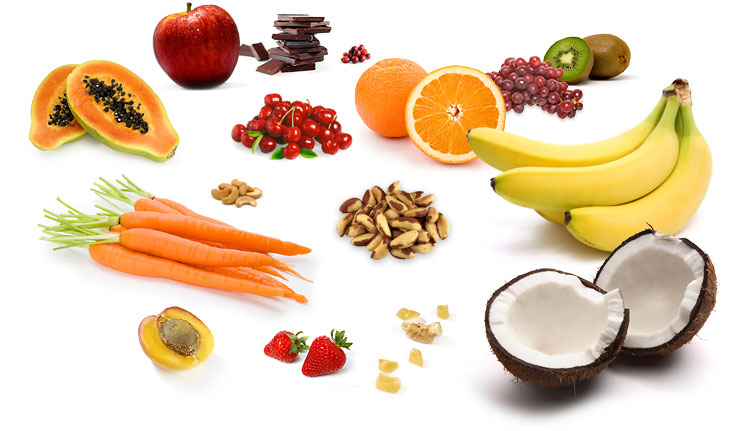Take a natural approach to food and enjoy the gourmet experience. A diet that benefits the heart and keeps the brain youthful encourages you to add variety to your plate—to feast on ripe fruit and vegetables, herbs and spices, and to luxuriate in the taste of well-raised meat and wild fish bought fresh and prepared simply. Natural foods contain a startling number of antiaging ingredients. These include heart-friendly fats, protective plant substances, and youth-preserving antioxidants that can neutralize free radicals— the unstable molecules that kickstart the body’s aging processes prematurely and are increased in the body by exposure to stress, pollution, UV rays, cigarette smoke, and unhealthy fats.
Natural nutrition with Food, without so-called supplements
Eating food in as close to its natural state as possible helps ensure maximum exposure to youth-enhancing nutrients, many of which are lost during storage, processing, and cooking. It also reduces your exposure to artificial additives used to enhance the flavor, texture, color, and shelf-life of processed foods, from prepared meals to diet dishes.

[wp_ad_camp_1]
#1 – Five a day
Keep looking and feeling young and help ward off diseases of aging, from Alzheimer’s to stroke and heart disease, by eating more fruit and vegetables. They are rich in antioxidants, and the biologically active ingredients of plant pigments and flavorings have antiaging properties, too. Aim to eat a minimum of five portions of fruit and vegetables daily—and up to nine if you can.
#2 – Fitting in fruit
To boost the number of fruit servings you eat each day, slice fresh fruit or spoon soaked dried fruit onto morning muesli. Snack on grapes, dried fruit and berries, and eat an apple or banana midmorning or afternoon. Follow meals with a fruit salad, baked or poached fruit, or treat yourself to pieces of fruit dipped in fine dark melted chocolate.
#3 – Color combos
A rainbow of colors on the plate ensures you are getting a good intake of plant chemicals. Naturally deep green, yellow, and red foods contain antioxidant carotenoids that boost immunity and offer protection against heart disease, cancer, DNA damage, and age-related sight problems. Include peppers, broccoli, spinach, sweet potatoes, carrots, and pumpkin in your diet, plus extravirgin olive oil to aid absorption.
#4 – Fresh is best
Choose ripe, seasonal fruit and vegetables and grains in their whole form to ensure maximum flavor while retaining vitamins and minerals, antioxidant compounds, and other plant nutrients that are destroyed by processing.
#5 – Grow your own
The best way to ensure the freshest, most flavorful organic fruit and vegetables is to grow them yourself. Even a city balcony can provide a good supply of tomatoes, salad leaves, herbs, and soft fruit.
#6 – Increasing variety
Diversity is the key to a healthy diet, since no one food can provide all the nutrients and antioxidants the body needs. Be adventurous and introduce new foods when you can.
#7 – Think like a vegetarian
Plant foods contain such life enhancing properties that long-term vegetarians are 20 percent less likely to die prematurely than meat eaters. You don’t have to become a vegetarian to reap the benefits. Serve meals with two or three vegetables and salads on the side, and add extra vegetables to dishes such as stir-fries, casseroles, and soups.
#8 – Resensitize your tastebuds
If your diet majors on slimming foods and processed meals, you might be amazed by the taste of fresh produce. Rediscover the difference by sampling organic carrots and butter, sourcing milk from special breed cows and seeking out meat that has been raised and hung well.Rid your kitchen of products such as cookies and potato chips, storebought cakes and pies, margarine, and low-fat foods, all of which have long lists of unwanted ingredients.
[wp_ad_camp_3]
#9 – Ditch dieting
Change the way you think about food and you need never worry about dieting again. Eating mostly fresh, seasonal fare frees you from faddy diets and prevents the yoyoing weight loss and gain that often accompanies dieting (and, dermatologists state, contributes to aged-looking skin). Instead of obsessing over the scales, judge your weight by how well your clothes fit.
#10 – Cut down on calories
If you are carrying excess weight and it won’t budge, it may be because you now need fewer calories. Over 50s who aren’t active need 200 fewer calories per day than those who lead a very physically active life. Adjust your diet to accommodate your slowing metabolism, for example, by reducing portion size rather than by cutting out foods.
# 11 – Appetite adaptations
As you age, you may find you can’t tolerate large portions. Increase the amount of exercise you get to boost appetite: aim for 30 minutes a day. Make sure that what you do eat contains plenty of protein, vitamins, and minerals, since these nutritional needs don’t decline with the years.
#12 – Choosing good carbs
Good carbohydrates are unrefined, rich in nutrients and fiber, high in flavor, and keep you feeling satisfied for hours. Aim for six servings a day if you are not very active; up to nine if you do more exercise. Choose brown and wild rices, oats, seeded wholemeal loaves, wholewheat pasta. Even a home baked cake such as lemon cake made with polenta and pistachios supplies good carbs. If you’re used to fresh home-cooked food, bad carbs are obvious because they don’t taste good: chewy white bread, soggy processed quiche and pizza bases, sugary breakfast cereals, cake that never goes off. Avoid them altogether.
(…continued to next page)










